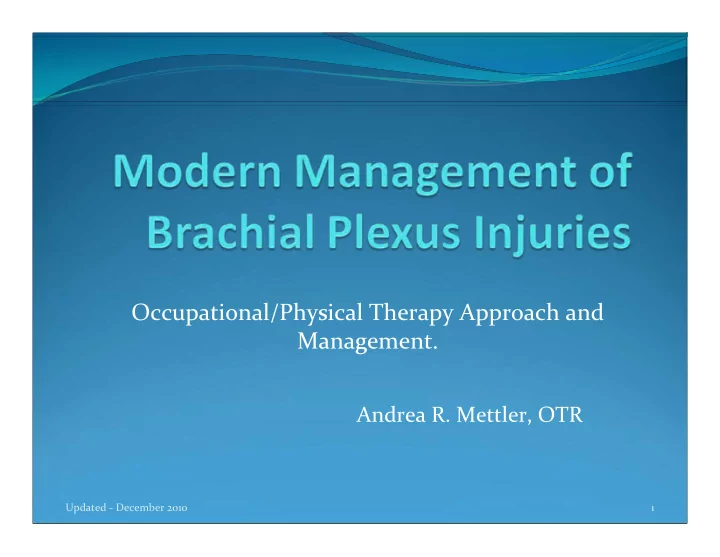

Therapy�Evaluations � Long�Term�Considerations � Posture � Self�injury � Developmental�skills � ADL’s Updated�� December�2010 41
Therapeutic�Management Updated�� December�2010 42
OBPI�Treatment�Infant� � Need�to�determine�frequency�of�OT/PT�session � Why�it�is�important�to�treat�infants�more�often? � When�should�treatment�begin? Updated�� December�2010 43
BPI�Treatment� Essential�Beginnings Teach�parent�ROM�exercises If�they�are�not�comfortable�doing�them,�show�them� hand over�hand�to�show�the�exact�range�available Updated�� December�2010 44
Treatment/Infants � PROM Should�be�performed�through�full�comfortable�range but�should�be�gentle�and�pain�free If�clavicular fracture�present�avoid�ROM�for�ten�to� fourteen�days�as�per�MD’s�orders Updated�� December�2010 45
Treatment�Positioning Infants: No�longer�pinning�arm�to�chest�unless� fracture�present Older�infants�(4�month�+) Supine�and�Prone Shoulder�abducted�to�90�degrees� with�external�rotation Updated�� December�2010 46
Updated�� December�2010 47
Treatment�Goals � 1 st priority � FAMILY�EDUCATION including�traditional�treatment:�ROM,�scapular;�� gleno�humeral�stabilization Precautions/plans Carrying�and�feeding�the�infant�with�OBPI Car�seat�position Diagnostic�work�up,�specialists Updated�� December�2010 48
Treatment�Goals � Maintain�PROM/prevent�contractures � Obtain�AROM � Preserve�joint�integrity � Promote�age�appropriate�developmental�skills� acquisition Updated�� December�2010 49
Treatment�Goals � Promote�sensory�awareness�of�involved�UE�in�hopes� of�reducing�apraxia � Promote�visual�awareness�of�involved�UE�(midline) � Prevent/minimize�compensatory�patterns�of� movement � Monitor�potential�associated�problems medial�rotation�posture/deformity�related�to�muscle imbalances�� Updated�� December�2010 50
Updated�� December�2010 51
Updated�� December�2010 52
Treatment/Infants � PROM�points�to�remember radial�head�dislocation support�normal�scapulohumeral rhythm Updated�� December�2010 53
Updated�� December�2010 54
Treatment�AROM � Early�facilitation�of�AROM�is�critical�for�the� prevention�of�learned�nonuse General�Guidelines � Start�in�gravity�eliminated�or�gravity�reduced�position� when�eliciting�concentric�contraction � Reflexes�can�be�helpful�to�elicit�muscle�contraction � Weakness�can�develop�in�muscles�not�directly� affected�by�the�lesion Updated�� December�2010 55
Updated�� December�2010 56
Treatment�AROM � Facilitation�of�shoulder�stability�is�the�foundation�for� controlled�arm�and�hand�function � Weight�bearing�and�weight�shift�in�prone � Assisted�reach�while�in�prone Vibration/tapping�to�rhomboids � Promote�scapular�weightbearing facilitates�co� contraction�both�with�scapular�movers�and�stabilizers � Activation�of�abdominals Updated�� December�2010 57
Updated�� December�2010 58
Updated�� December�2010 59
Facilitation�of�Reach � Gentle�humeral�compression�during�reach � Humeral�guidance�while�facilitating�humeral�flexion� and�ER�(inhibit�excessive�humeral�abduction) � Stabilizing�and�mobilizing�scapula � Facilitate�reach�without�grasp,�but�reach�to�touch� easier Updated�� December�2010 60
Updated�� December�2010 61
Facilitation�of�Supination � Early�supination begins�with�elbow�flexion � Get�shoulder�in�neutrally�rotated�position�first � Cylindrically�shaped�toys�presented�in�vertical�fashion � Facilitates�supination � Present�toys�to�radial�side�of�hand Updated�� December�2010 62
Facilitation�of�Supination � Treatment�Strategies Encourage�hand�to�mouth�and�toy�to�mouth�play Finger�feeding Bimanual�holding�of�toys Banging�blocks Holding�bottle�at�feeds Stickers�on�palmer�surface�or�wrist� Weight�shifting�while�in�prone Updated�� December�2010 63
Updated�� December�2010 64
Updated�� December�2010 65
Facilitation�of�ER Gentle�stretch�to�pectorals�is�essential� MFR,�strain/counterstrain Gentle�joint�mobilization Massage Trunk�rotation�while�weight�bearing�on�fixed�(involved)� UE Reaching�out�to�side�with�humerus fixed�against�trunk Updated�� December�2010 66
Updated�� December�2010 67
Facilitation�of�Grasp � Treatment�Strategies Toy�to�mouth Traction�and�propioceptive input�through�palm Weight�bearing�through�palm/correction�of���� weight�bearing�through�dorsal�surface� Hold�large�object�requiring�two�hands Use�velcro strap�on�hand�to�maintain�hold Updated�� December�2010 68
Updated�� December�2010 69
BPI�Treatment�infant Teach�Parents Proper�positioning Sensory�stimulation Visual�orientation Proper�carrying�and�picking�up�techniques� Updated�� December�2010 70
Treatment�Positioning Sidelying on�uninvolved�side�to�promote� midline�orientation�of�involved�limb�as�well�as� spontaneous�play Sidelying on�involved�side�trunk�should�be� reclined�back�slightly�towards�supine�to�avoid�undue� pressure�(if�hemidiaphragmatic,�this�should�be�limited� but�still�performed) Updated�� December�2010 71
BPI�Treatment Tummy�time Essential�for�preparation�for�future�use Updated�� December�2010 72
Updated�� December�2010 73
BPI�Treatment Sensory�Stimulation Facilitate�involved�arm Exploring�other�body�parts Provide�infant�massage�over�involved�limb Provide�vibratory�input Provide�joint�compression Provide�variety�of�textures Alter�temperature�of�toys Updated�� December�2010 74
Treatment� Visual�Input Involved�arm�should�always�be�in�visual�field�to�reduce� chances�of�developmental�apraxia of�nonuse Place�bell�on�small�wrist�band�to�encourage�child�to� look at�arm�when�spontaneous�movement�occurs Updated�� December�2010 75
Updated�� December�2010 76
BPI�Treatment � Use�of�vibration�can�achieve�a�lot�at�young�age � Can�activate�muscle � Promote�sensory�awareness � Assist�with�nerve�re�generation Updated�� December�2010 77
Updated�� December�2010 78
BPI�Treatment� Developmental�Sequence General�points�of�consideration Utilize�age�appropriate�activities Keep�it�fun�through�variety�of�stimulation Insure�successful�experience Watch�entire�body�for�compensations Updated�� December�2010 79
Updated�� December�2010 80
BPI�treatment� Transitional�Movement Rolling�supine�to�sidelying to�prone�(and�vice�versa) Always�to�both�sides Weight�shift�in�sitting Creeping�on�hands�and�knees Updated�� December�2010 81
BPI�Treatment/NMES Updated�� December�2010 82
BPI�Treatment/ Constrained�induced Updated�� December�2010 83
Updated�� December�2010 84
BPI�Treatment� Splinting Goals Prevent�contractures Promote�increased�function Protect�joint Deficits�determine�splinting�needs not�all�infants�need�splinting. Updated�� December�2010 85
Updated�� December�2010 86
Updated�� December�2010 87
Updated�� December�2010 88
Updated�� December�2010 89
Updated�� December�2010 90
Updated�� December�2010 91
Therapy�Intervention�Following�Mod�Quad�Procedure Updated�� December�2010 92
Updated�� December�2010 93
Updated�� December�2010 94
Post�Surgical�Rehab/ Mod�Quad � Statue�of�Liberty�(SOL)�splint�is�removed�by�OT�on� post�op�day�# 1 to�assess�current�shoulder�AROM � AROM�tested�anti�gravity�&�gravity�eliminated�planes � Based�on�AROM�findings�decision�on�splint�wearing� time�is�made � AROM�might�be�restricted�by�pain�and�dressings � Typically�infants�sleep�with�SOL�for�3�weeks Updated�� December�2010 95
Post�Surgical�Rehab/ Mod�Quad � Typically�infants�under�12�18�months�do�not�need� splinting�during�day�time Splinting�at�night�time�only�for�3�weeks � Children�2�+�more�aware�of�pain�and�discomfort � Might�need�splinting�18/7�for�1�3�weeks � Splint�is�to�promote�healing�and�for�pain�control � Important�to�remove�splint�1�2�hours�at�least�2�x�day Updated�� December�2010 96
Updated�� December�2010 97
Post�Surgical�Rehab/ Mod�Quad � AROM/AROM�begin�immediately � Infant’s and younger children restrict AROM on non� affected�extremity�(elbow�splint) � Children�12+:�pillow�splint�with�shoulder�at�80/90� degree�angle�to�prevent�numbness/tingling � Protocol�for�older�children�varies�and�AAROM/AROM� begin�at�post�op�day�#1�and�performed�every�hour Compensatory patterns big problem for older children Updated�� December�2010 98
Post�Surgical�Rehab/Mod�Quad � Formal�therapy�typically�resumes�at�post�op�weeks�2�3 � Encourage�active�movement�and�function�through� play�and�participation�in�self�care�skills � Non�resistive�activities:�balloons,�bubbles,�magnets � Do�not�encourage�internal�rotation�or�adduction� at�the�shoulder Updated�� December�2010 99
Updated�� December�2010 100
Recommend
More recommend